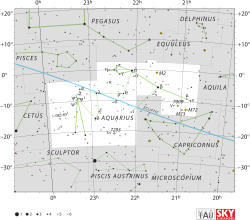| Observation data Epoch J2000 Equinox J2000 | |
|---|---|
| Constellation | Aquarius |
| Right ascension | 23h 09m 54.89736s [1] |
| Declination | −22° 27′ 27.4192″ [1] |
| Apparent magnitude (V) | +4.69 [2] |
| Characteristics | |
| Spectral type | G3 II + A2 V [3] |
| U−B color index | +0.39 [2] |
| B−V color index | +0.65 [2] |
| Astrometry | |
| Radial velocity (Rv) | −4.8 [4] km/s |
| Proper motion (μ) | RA: +32.61 [1] mas/yr Dec.: −9.76 [1] mas/yr |
| Parallax (π) | 6.47±0.68 mas [1] |
| Distance | approx. 500 ly (approx. 150 pc) |
| Absolute magnitude (MV) | 0.1/1.5 [5] |
| Details | |
| 89 Aqr A | |
| Mass | 2.9 [5] M☉ |
| Surface gravity (log g) | 3.62 [6] cgs |
| Temperature | 5,640 [6] K |
| Metallicity [Fe/H] | +0.27 [6] dex |
| Age | 320 [5] Myr |
| 89 Aqr B | |
| Mass | 2.0 [5] M☉ |
| Temperature | 8,912 [5] K |
| Other designations | |
| CD−23 17771, HIP 114375, HR 8817, SAO 191687. [7] | |
| 89 Aqr A: HD 218640. | |
| 89 Aqr B: HD 218641. | |
| Database references | |
| SIMBAD | data |
89 Aquarii (abbreviated 89 Aqr) is a binary star [3] system in the equatorial constellation of Aquarius. 89 Aquarii is the Flamsteed designation, though it also bears the Bayer designation c3 Aquarii. [8] The apparent visual magnitude of +4.69 [2] is bright enough to be seen with the naked eye. Its distance from Earth is roughly 500 light-years (150 pc), based upon parallax measurements with an 11% margin of error. [1]
The primary component of this system has a magnitude of 5.27 and a stellar classification of G3 II, which suggests this is an evolved star in the bright giant stage. The companion is an A-type main sequence star with a stellar classification of A2 V. [3] As of 2010, it is located at an angular separation of 0.1843 arcseconds along a position angle of 135.1°. [9] They orbit each other with an estimated period of 201 years and a semimajor axis of 0.45 arcseconds. [5]
